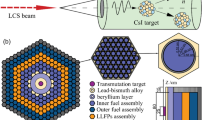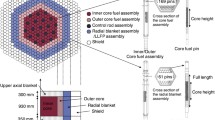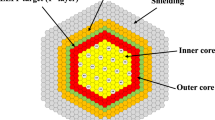Abstract
This study aims to produce 229Th using an innovative nuclear reactor concept, i.e., accelerator-driven system (ADS) reactor. Herein, we investigated the feasibility of producing 229Th from neutron transmutation of 226Ra to expand the availability of 225Ac and 213Bi in a simple model of ADS reactor. ADS reactor comprises two zones, i.e., an inner zone with a fast neutron spectrum and outer zone with thermal neutron spectrum, which is a subcritical core coupled with an external neutron source. Transmutation behavior, activity, and mass ratio of the obtained isotopes were investigated using the Monte-Carlo tool. In addition with offering the capability, flexibility, and safety of radioactive waste transmutation, the proposed ADS model provides high 229Th yield and requires less time than a critical reactor with the same neutron flux and irradiated quantity of 226Ra.
Similar content being viewed by others
Avoid common mistakes on your manuscript.
1 Introduction
Radioisotopes have become a fundamental part of medical diagnostic procedures, especially for cancers and cardiovascular diseases. In combination with monitoring devices which record the gamma rays emitted from within, they can study the dynamic processes taking place in various parts of the body. In therapy, the uses of radioisotopes are relatively few, but still important. Cancerous growths are sensitive to damage by radiation. Therefore, some cancerous growths can be controlled or eliminated by irradiating the area containing the growth [1]. The growing use of radioisotopes for the treatment of several cancers has prompted the investigation of further alternative production routes to satisfy the demand for medical isotopes [2]. Currently, there are many approaches to producing these isotopes; for example, targeted alpha therapy uses 225Ac and 213Bi, which are considered the most important alpha-emitting isotopes. These two radioisotopes are obtained by producing 229Th in a reactor [3, 4]. Oak Ridge National Laboratory and the High Flux Isotope Reactor are the main suppliers of high-purity 225Ac from the decay of existing 229Th stocks. Approximately 26 GBq of 225Ac has been produced annually from the 229Th stock, typically in six campaigns per year [5]. The evaluation of accelerator routes, including the production of 225Ac via the 226Ra (p, 2n) and 226Ra (γ, n) nuclear reactions, has also gained momentum. Another production approach using a high-energy accelerator has been investigated as well, employing intense 100, 200, or 800 MeV proton beams and natural thorium targets for the large-scale production of the therapy isotopes 223,225Ra, 225,227Ac, and 227Th [2].
Herein, we investigate the ADS reactor approach, which has attracted considerable attention for isotope production/transmutation, as shown in Fig. 1. ADS is a subcritical reactor, and it can play an important role in the transmutation process of heavy elements and isotope production [6, 7]. This type of reactor was essentially designed for safely transmuting radioactive waste into stable elements or elements with relatively short-lived radioactivity, while producing useful power [8,9,10,11,12]. ADS possesses some advantages because the accelerator provides further neutrons through the interaction of accelerated particles with a target mostly located at the center of core, in addition to the neutrons coming from fission. Therefore, it is expected to be more efficient from the viewpoint of burnup characteristics than critical reactors [6, 13, 14]. Since ADS reactors are not required to maintain criticality, it is possible to increase burnup, i.e., to extract more energy from a given mass of fuel and more neutron flux in the core, where the neutron intensity is an important factor in transmutation processes and isotope production [15, 16].
(Color online) Accelerator-driven system (ADS) concept [17]
The transmutation of 226Ra to 229Th through neutron irradiation requires three neutron captures and two β− decays through a number of pathways [5], and the dominant production pathway is via:
This study aims to investigate the feasibility of 229Th production via transmutation of 226Ra in an ADS reactor to provide 225Ac and 213Bi at the end according to the decay scheme based on 229Th. The ADS reactor model has two regions, i.e., an outer zone, which has a thermal neutron spectrum in which 226Ra is irradiated, and an inner zone, whose fast spectrum serves as a radioactive waste incinerator. Isotope formation from the irradiation of 226Ra is calculated using MCNPX and CINDER’90 for solving the time-dependent Bateman equations [18].
2 ADS core description and model
The current ADS reactor model comprises a subcritical core with two regions (zones), as shown in Fig. 2a. The fast spectrum zone surrounds the central tube, which is contained in a tank made of stainless steel. The fast zone is filled with fuel elements, but made up of plutonium, americium, and curium samples (Pu, Am, and Cm)O2 within MgO, with a density of 6.077 g/cm3 [19]. The sample was put together for investigating high-level radioactive waste transmutation; this study has been conducted already with the same model of two zones and will be submitted for publication soon. The inner zone is surrounded by thermal spectrum zone comprising shortened fuel pins, with 4% enriched uranium (a more detailed description of the core is given in Table 1). The main geometrical and material characteristics of this model are based on the previous investigations performed at the Institute for Safety Problems of Nuclear Power Plants (NPPs) and the Institute for Nuclear Research, Kyiv, Ukraine [20, 21].
The high-intensity neutron generator will be used as a driver for the subcritical reactor [22]. For the source definition of external neutron source in ADS, charged particles (deuterons) move from the top to the bottom of the central tube of the system and finally hit the titanium target saturated with tritium. The fusion of a deuterium and tritium nucleus (D-T nuclear reaction) results in the formation of a 4He nucleus and a neutron with a kinetic energy of approximately 14 MeV. For the purpose of simplicity and normalization in the MCNPX model, a point isotropic source with neutron energy of 14 MeV has been identified in the input file.
3 Results and discussion
3.1 226Ra target position characteristics
Calculations for the current model were performed using the MCNPX 2.7 transport code with the ENDF/B-VII.0 data library [23]. The initial subcriticality was fixed at 0.97 ± 0.0006. One kg of 226Ra target was irradiated at different positions in the outer zone, and this was repeated for 16 time steps, which is representative of 4 years of operation. To select the typical position for production of 229Th using a thermal neutron flux of about 2.0 × 1014 n/cm2 s, the neutron spectrum was calculated at six different distances from the center of the core, i.e., at 21, 27, 33, 39, 45, and 51 cm (referred to in Fig. 3 as TP1, TP2, TP3, TP4, TP5, TP6, respectively).
The neutron flux changes with the target position (TP) as observed in Fig. 3, especially in the region of the hard spectrum, in which the presence of fast neutrons increases whenever we approach the inner zone. Although there is no large difference in the thermal and epithermal regions with the target position, we can see a slight difference in neutron flux at TP3.
To further assess the typical TP selection, we also calculated 229Th yields in units of activity at the same six TPs with time using the depletion input card tally (BURN). BURN calculates the changes in isotope concentration over time based on the CINDER’90 package in combination with MCNPX. Figure 4 shows that 229Th yields vary with the target position, with a typical value of 0.63 GBq/g of 226Ra after 2.5 years at TP3, which is 33 cm away from the core center (as illustrated in the model view in Fig. 2b). Based on this analysis, the optimal irradiation position for the production of 229Th would be at TP3. This preference for TP3 is due to a relatively high neutron flux in the range of epithermal energy, where the \({}^{226}{\text{Ra}}[n,\gamma ]\) reaction is more likely to take place; therefore, the production of 229Th is expected to be greater at TP3. It is worth mentioning that the maximum yields for TP5 and TP6 are at 3 and 3.5 years with activity values corresponding to 0.61 and 0.60 GBq/g, respectively; after this time, the activity begins to decrease. This means that the neutron energy becomes more thermalized after TP3 with time, which makes the neutron absorption reaction less likely.
3.2 Evaluation of the production of 229Th, 228Th, and 227Ac in the ADS model
After selecting a typical target irradiation position in the outer zone, we fixed the position and changed the neutron flux used for irradiation of the 226Ra target to evaluate the behavior of the yields of 227Ac, 228Th, and 229Th from 226Ra with neutron flux. These calculations are aimed at estimating the increasing rate of the desired isotope and the expected time to achieve the maximum production amount as a function of flux.
Depending on the dominant formation pathway for 229Th, we expected that 227Ac and 228Th would be coproduced with 229Th. The yields for those isotopes as a function of irradiation time and at four different values of neutron fluxes (φ = 2.0 × 1014, 3.42 × 1014, 4.6 × 1014, and 6.84 × 1014 n cm−2 s−1) are shown in Fig. 5a–d, respectively. The results correspond to the route behavior, and production rate is sensitive to the neutron flux. The peaks of mass yield shift to the left of the time scale (i.e., to shorter time) with an increase in the neutron flux, particularly for 228Th and 229Th formation, wherein the first cycle contains a relatively large amount of 227Ac than the other two isotopes. The 227Ac yields produced through quick decay of \(^{227} {\text{Ra}}(t_{1/2} = \, 42.2,\beta^{ - } )\) in turn is formed from the \(^{226} {\text{Ra}}[n,\gamma ]\) reaction. Subsequently, the amount of 227Ac decreases with a dramatic increase in 228Th yield through the most likely reaction: \({}^{227}{\text{Ac}}[n,\gamma ]{}^{228}{\text{Ac}}(t_{1/2} = 6.15h,\beta^{ - } ){}^{228}{\text{Th}}\), which, in turn, transmutes to 229Th by neutron capture.
Table 2 shows the maximum production mass of 229Th as a function of time and flux. The irradiation time decreases from 2.5 years at a neutron flux equal to 2.0 × 1014 to less than one year when the neutron flux increases to 6.84 × 1014 and the 229Th yield increases by ~ 13%. These calculations are useful when considering the economic feasibility, or the cost of producing 229Th when increasing the neutron flux in the core.
We compared our method of calculating 229Th yields (from 1 kg of 226Ra irradiation at a neutron flux of 4.6 × 1014 n/cm2 s for four years in ADS using the two zones model), with that from a previous study [4] in which the production of 229Th was conducted in a critical core with the same amount of 226Ra target (1 kg) irradiated using a neutron flux of 4.7 × 1014 n/cm2 s. The results are shown in Fig. 6. Our ADS calculations indicate rapidly increasing 229Th yields during the first operation cycle up to 1.33 years of irradiation, before a decrease in yield at 1.5 years. The maximum amount of 229Th yield was 96.71 g from 1 kg 226Ra. In contrast, the production of 229Th in the critical core was relatively slow, reaching a maximum yield of 72.75 g from 1 kg 226Ra after 3.2 years.
This behavior of ADS with two zones can be attributed to the availability of two types of neutron spectrum, which allows for fast neutrons from the inner zone to penetrate the membrane to the outer zone, leading to significant numbers of epithermal neutrons in the outer zone near the membrane. Once those neutrons have been slowed down, they have a high probability of being captured by 226Ra. This model of neutrons penetrating a membrane cannot be used when we consider a critical core with two zones, because in this case there is no role for a membrane in addition to the two zones; the idea is to have two types of neutron spectrum inside the core. As mentioned before, the main aim of the ADS with two zones is to benefit from the fast zone for high-level waste transmutation and the thermal zone for long-lived fission product transmutation, in addition to isotope production.
4 Conclusion
The production of 229Th through irradiation of 226Ra was investigated numerically in a proposed ADS model with fast and thermal spectrum zones. We compared the results obtained using the proposed model with those obtained using a critical reactor.
Based on calculations, the two-zone ADS model can produce 229Th from 226Ra transmutation in addition to serving as a radioactive waste incinerator. The proposed model shows greater efficiency for producing 229Th than critical reactor (25%) in less time (58%), using the same initial amount of 226Ra and same neutron flux. Furthermore, the proposed model can produce a significant amount of 228Th, which is coproduced with 229Th during the irradiation of 226Ra. This is based on the fact that the fast neutrons from the inner zone penetrate the stainless steel membrane and move to the outer zone, thereby changing the neutron spectrum surrounding the inner zone. The presence of two types of neutron spectra in the core is useful for 226Ra transmutation and increases 229Th yields.
These results provide a strong basis to discuss and evaluate the needs for future research into the feasibility of producing 229Th in a different ADS model with one zone. They also allow for a comparison between calculations and available experimental results.
References
C. Doble et al. Application of radioisotopes in personalized medicine. Int. J. Pharm. Life Sci. 10(3), 20 (2019)
J.W. Weidner, S.G. Mashnik, K.D. John et al., 225Ac and 223Ra production via 800 MeV proton irradiation of natural thorium targets. Appl. Radiat. Isot. 70, 2590–2595 (2012). https://doi.org/10.1016/j.apradiso.2012.07.003
J.R. Griswold, D.G. Medvedev, J.W. Engle et al., Large scale accelerator production of 225Ac: effective cross sections for 78–192 MeV protons incident on 232Th targets. Appl. Radiat. Isot. 118, 366–374 (2016). https://doi.org/10.1016/j.apradiso.2016.09.026
J.N.C. Van Geel, J.J. Fuger, L. Koch. “Method for producing actinium-225 and bismuth-213.” U.S. Patent No. 5,355,394. 11 Oct. 1994. https://patents.google.com/patent/US5355394A/en
S. Hogle, R.A. Boll, K. Murphy et al., Reactor production of Thorium-229. Appl. Radiat. Isot. 114, 19–27 (2016). https://doi.org/10.1016/j.apradiso.2016.05.002
D. De Bruyn, H.A. Abderrahim, P. Baeten et al., The MYRRHA ADS project in Belgium enters the front end engineering phase. Phys. Procedia 66, 75–84 (2015). https://doi.org/10.1016/j.phpro.2015.05.012
H.A. Abderrahim, P. Baeten, D. De Bruyn et al., MYRRHA–A multi-purpose fast spectrum research reactor. Energy Convers. Manag. 63, 4–10 (2012). https://doi.org/10.1016/j.enconman.2012.02.025
C. Rubbia, C. Roche, J.P. Revol, et al. Conceptual design of a fast neutron operated high power energy amplifier. No. CERN-AT-95-44-ET. (1995). https://cds.cern.ch/record/289551/files/cer-0210391.pdf
C.D. Bowman, E.D. Arthur, P.W. Lisowski et al., Nuclear energy generation and waste transmutation using an accelerator-driven intense thermal neutron source. Nucl. Instrum. Methods A 320, 336–367 (1992). https://doi.org/10.1016/0168-9002(92)90795-6
A.A. Al Qaaod, H. Shahbunder, R.M. Refeat et al., Transmutation performance of uniform and nonuniform distributions of plutonium and minor actinides in TRIGA Mark II ADS reactor. Ann. Nuclear Energy 121, 101–107 (2018). https://doi.org/10.1016/j.anucene.2018.07.012
H. Shahbunder, A.A. Al Qaaod, E.A. Amin et al., Effects of Pu and MA uniform and nonuniform distributions on subcritical multiplication of TRIGA Mark II ADS reactor. Ann. Nucl. Energy 94, 332–337 (2016). https://doi.org/10.1016/j.anucene.2016.03.016
H.M. Al-Ssalahy, A.A. Al Qaaod, S.U. El-Kameesy et al., Evaluation of subcritical multiplication parameters in MYRRHA-FASTEF accelerator driven system reactor. J. Phys: Conf. Ser. 1253, 8 (2019). https://doi.org/10.1088/1742-6596/1253/1/012028
M. Salvatores, Accelerator driven systems (ADS), physics principles and specificities. Le Journal de Physique IV (1999). https://doi.org/10.1051/jp4:1999702
C. Rubbia, J. Aleixandre, S. Andriamonje. A European roadmap for developing accelerator driven systems (ADS) for nuclear waste incineration. ENEA Report 88 (2001)
W.M. Stacey, Z. Abbasi, C.J. Boyd et al., A subcritical, helium-cooled fast reactor for the transmutation of spent nuclear fuel. Nucl. Technol. 156, 99–123 (2006). https://doi.org/10.13182/NT06-A3777
A. Fokau, Y.P. Zhang, S. Ishida et al., A source efficient ADS for minor actinides burning. Ann. Nucl. Energy 37, 540–545 (2010). https://doi.org/10.1016/j.anucene.2009.12.025
X.S. Yan, L. Yang, X.C. Zhang et al., Concept of an accelerator-driven advanced nuclear energy system. Energies 10, 944 (2017). https://doi.org/10.3390/en10070944
M.L. Fensin, M. Umbel, Testing actinide fission yield treatment in CINDER90 for use in MCNP6 burnup calculations. Prog. Nucl. Energy 85, 719–728 (2015). https://doi.org/10.1016/j.pnucene.2015.09.001
S. Lemehov, V. Sobolev, K. Govers et al. Progress and advancements in fuel performance modelling for MYRRHA/XT-ADS. No. INIS-XA–09N0647. 2009
V.A. Babenko, V.I. Gulik, L.L. Jenkovszky et al., On the subcritical amplifier of neutron flux based on enriched uranium, in Nuclear Science and Safety in Europe, ed. by T. Cechák, L. Jenkovszky, I. Karpenko (Springer, Dordrecht, 2006), pp. 253–263. https://doi.org/10.1007/978-1-4020-4965-1_21
V.O. Babenko, V. I. Gulik, and V. M. Pavlovych. The new research subcritical reactor driven by a high-intensity neutron generator for transmutation of the nuclear waste. in Proceedings of International Conference “Current Problems in Nuclear Physics and Atomic Energy”(NPAE2010). (2010)
V. Gulik, A.H. Tkaczyk, Cost optimization of ADS design: comparative study of externally driven heterogeneous and homogeneous two-zone subcritical reactor systems. Nucl. Eng. Des. 270, 133–142 (2014). https://doi.org/10.1016/j.nucengdes.2014.01.007
M.B. Chadwick, P. Obložinský, M. Herman et al., ENDF/B-VII. 0: next generation evaluated nuclear data library for nuclear science and technology. Nucl. Data Sheets 107, 2931–3060 (2006). https://doi.org/10.1016/j.nds.2006.11.001
Author information
Authors and Affiliations
Corresponding author
Additional information
This work was supported by the International Center for Theoretical Physics and the Institute of International Education’s Scholar Rescue Fund.
Rights and permissions
About this article
Cite this article
Al Qaaod, A.A., Gulik, V. 226Ra irradiation to produce 225Ac and 213Bi in an accelerator-driven system reactor. NUCL SCI TECH 31, 44 (2020). https://doi.org/10.1007/s41365-020-00753-2
Received:
Revised:
Accepted:
Published:
DOI: https://doi.org/10.1007/s41365-020-00753-2










